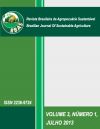FORAGE PRODUCTION AND MORPHOPHYSIOLOGICAL CHARACTERISTICS OF MULATO GRASS IN CULTIVATED CERRADO OXISOL AS A FUNCTION OF NITROGEN AND POTASSIUM LEVELS
DOI:
https://doi.org/10.21206/rbas.v3i1.192Abstract
The maintenance and productivity of forage plants may have their efficiency maximized by increased use of fertilizers. In this sense, this work aimed to determine the influence of combinations of these nutrients in the productive (forage production, tillering and leaf area estimates) and morphophysiological (RSE, NLL, NLT, LBL, LAR, RELB, RLS and LL) characteristics during three stages of growth of Brachiaria hybrida cv. Mulato. The experiment was carried out in a greenhouse at CCAA/UFMA. A completely randomized design with factorial arrangement 4 x 2 (four doses of N and two doses of K) were used, comprising eight treatments and five replicates, totaling 40 experimental units. The treatments consisted of increasing doses of nitrogen: 0, 75, 150 and 225 kg/ha and two levels of potassium fertilization: 20 and 60 kg/ha of K2O. For the production characteristics, in the first cut, there was effect for the production of fodder, in which the behavior of the equation was similar to the doses of 20 and 60 kg/ha of K2O, but the magnitude of response was higher for the dose of 60 kg/ha of K2O, which did not occur to tillering of the grass that regardless of the dose of K, in which the higher the dose of N, greater was the tillering. For the estimation of leaf area there was no statistical difference of any factor studied. In the second and third cuts, the total forage yield, tillering and leaf area were influenced only by rates of N. In all cases, the equations fitted the linear regression model. Like the production characteristics, the morphophysiological characteristics have different responses over the cuts, which show that the management of Mulato grass should not be generalized, because it depends on the stage of growth/development of plants. The N influenced positively the productive and morphophysiological characteristics of Mulato grass being the influence more evident through the supply of 60 kg/ha of K2O.Downloads
Download data is not yet available.
Downloads
Published
2013-07-01
How to Cite
Sâmara Stainy Cardoso Sanchês, Carlos Magno Lima Galvão, Rosane Cláudia Rodrigues, Jefferson Costa de Siqueira, Ana Paula Ribeiro de Jesus, Jocélio dos Santos Araújo, Thiago Vinícius Ramos de Sousa, & Antonio Lima da Silva Junior. (2013). FORAGE PRODUCTION AND MORPHOPHYSIOLOGICAL CHARACTERISTICS OF MULATO GRASS IN CULTIVATED CERRADO OXISOL AS A FUNCTION OF NITROGEN AND POTASSIUM LEVELS. Brazilian Journal of Sustainable Agriculture, 3(1). https://doi.org/10.21206/rbas.v3i1.192
Issue
Section
Artigos
License
1. Proposta de Política para Periódicos de Acesso Livre
Autores que publicam nesta revista concordam com os seguintes termos:
Autores mantém os direitos autorais e concedem à revista o direito de primeira publicação, com o trabalho simultaneamente licenciado sob a Licença Creative Commons Attribution que permite o compartilhamento do trabalho com reconhecimento da autoria e publicação inicial nesta revista.












